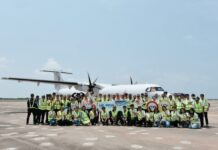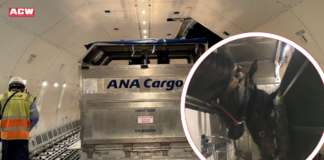Air France-KLM (AF-KLM) has seen its revenue tonne kilometres (RTK) dip to 833 million in August, down from July, continuing the volatile trend seen throughout 2014.
Total RTK has been rising and falling throughout the year, with only January, February and March posting consecutive rises, of 773 million, 790 million and 898 million, respectively. In April it dipped to 831 million, rising to 842 million in May, dropping again in June to 800 million, increasing again in July to 841 million before declining again in August to 833 million. Year-to-date (YTD) RTK fell by 0.3 per cent while available tonne kilometres (ATK) was down 1.2 per cent meaning load factor was up 0.6 per cent.
All regions have seen have seen declines in RTK in August, with exception of the Americas, which saw it rise from 349 million in July to 351 million. The Americas has been the most consistent region throughout 2014, though it is still down on the year’s high of March, when RTK was 373 million. For YTD, the RTK was up one per cent while ATK was down 0.2 per cent; meaning the load factor was up 0.7 per cent.
Asia Pacific has had the highest load factor, but August was a weaker month at 75.9 per cent. The load factor rose in the first quarter months from 75.6 per cent in January, to 78.2 per cent in February and 81.7 per cent in March. It declined in April, May and June from 77.9 per cent, 77.1 per cent and 75.8 per cent, respectively. It rose again in July to 77.7 per cent before dipping in August. Short and medium haul saw the worst figures, with RTK dropping from six million in July to five million in August. The ATK has increased 2.5 per cent YTD, but RTK has decreased 2.9 per cent over the same period. The load factor has declined from 13.4 per cent in February, to 10.1 per cent in August, the worst month of the year.
Due to AF-KLM’s poor financial results, Air France-KLM-Martinair Cargo (AF-KL-MP) is to speed up the withdrawal of its Boeing MD-11 Freighters, restructuring its operations for more bellyhold freight.
Five freighters operated by Martinair Cargo will be retired between mid-2015 and mid-2016. They were to have been phased out between now and 2022, but the stagnation of the air cargo sector and the ever-increasing supply of cargo capacity passenger aircraft bellyholds have forced the group to move more quickly. By the end of 2016, the group’s freighter fleet will consist of two Air France Boeing 777 Freighters, operating out of Paris Charles de Gaulle Airport, and three Boeing 747 Extended Range Freighters, flying from Amsterdam Airport Schiphol. That compares with a fleet of 13 freighters operating under the combined carriers’ auspices in 2013.
The accelerate retirement decision had been taken by the Air France-KLM board of directors only hours before a 4 September press conference at Schiphol. Other options considered include, investing in new generation more efficient freighters, partnering with other carriers to achieve synergy efficiencies and selling Martinair Cargo. These were rejected because, new freighters would have made insufficient difference to the bottom line, an ideal carrier partner could not be found and Martinair’s slots and position in the Latin American market are too valuable to divest.
At the press conference, KLM managing director Erik Varwijk explicitly ruled out the sale of Martinair. Varwijk expects AF-KL-MP to concentrate on carrying high value freight such as pharmaceuticals and express. He claims the group’s worldwide network will hardly be affected by the accelerated freighter retirement. He did not rule out boosting freighter capacity should there be a sizeable recovery.












